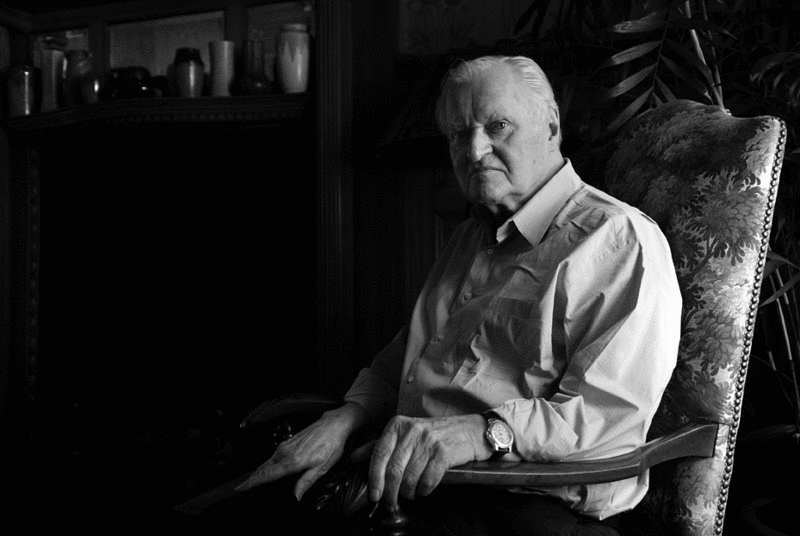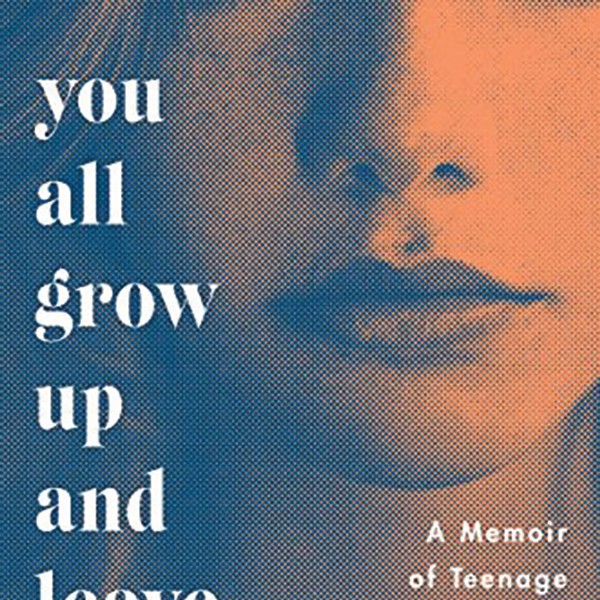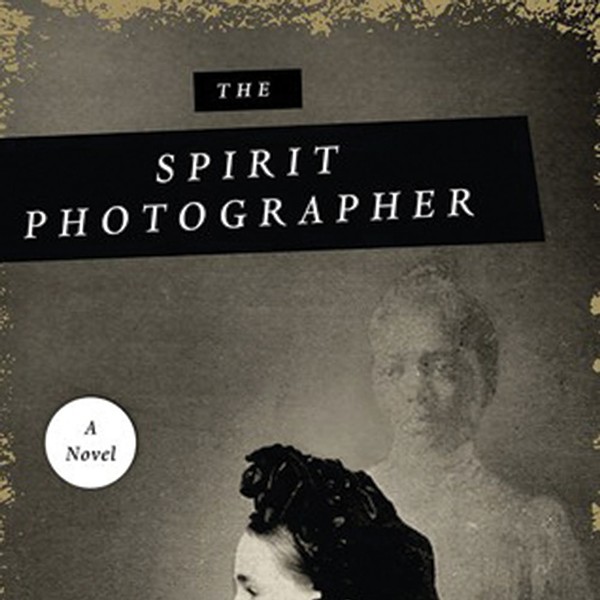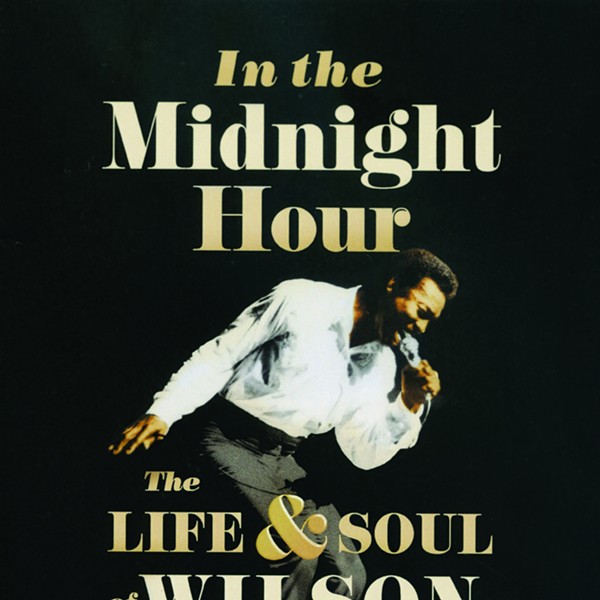Attention, shoppers.” This may not be the opening gambit most readers expect from a poet who’s won every major award in the pantheon, but John Ashbery often defies expectations: These K-Mart tinged words launch his poem “Wolf Ridge.”
There are few laudatory adjectives that critics haven’t applied to Ashbery’s 26 books of poetry; “dazzling,” “sublime,” and the like become shopworn. His 1975 Self-Portrait in a Convex Mirror won an unprecedented triple crown, garnering the National Book Award, the National Book Critics Circle Prize, and the Pulitzer. This September, Bard College hosted a celebration honoring the poet’s 80th birthday, drawing such overflow crowds for three days of panel discussions and readings that practically every event was moved into a larger venue.
This month, Ecco will release Notes from the Air: Selected Later Poems, and the literary magazine Conjunctions will devote some 150 pages of its 49th issue to Ashbery and his work. “John has been a contributor and dear friend for almost as long as Conjunctions has been going,” says editor Bradford Morrow. “I’ll never forget the exceptionally moving first lines of the first poem he ever sent me for publication—‘To have been loved once by someone—surely / There is a permanent good in that.’ He’s a colleague at Bard and, to my mind, the most influential, important poet alive. His poetry investigates voice and what can be voiced in its every gesture. It soars, shimmers, and bristles with both street smarts and hieratic wisdom.”
Ashbery divides his time between a Manhattan apartment and a magisterial Victorian home in Columbia County. His partner of 37 years, David Kermani, a slight, dark-haired man with a seemingly permanent smile, opens the door to an alternate universe. He ushers his guests through the oak-paneled entryway, past a huge stained-glass window of striking amber and butterscotch hues, and into a formal dining room lined with deeply textured maroon wallpaper. Like the woodwork, beveled mirrors, and tile fireplaces, it’s original to the house. The careful arrangements of porcelain geishas, trompe l’oeil plates, Little Orphan Annie teacups, and the like are pure Ashbery.
The eclectic mix of architectural classicism and vintage curios mirrors the juxtapositions of high and low diction in Ashbery’s poems. The late Jim Ryan, curator of nearby Olana, once told Kermani, “Someday this house is going to be seen as a major work by John Ashbery.” Kermani ran with the concept, publishing an essay called “In Context: ‘Created Spaces’ as a New Resource in Ashbery Studies” in LIT magazine, in which he described these live-in collages as “a kind of physical poetry.”
“Of course, John won’t say any of this is conscious, just the way he won’t discuss the meaning of his poems. He’ll just tell you he wants to provide a congenial atmosphere for himself,” Kermani says, leading the way through a butler’s pantry with a well-stocked bar and into the kitchen. This room is distinctly unmuseumlike: Its center table is piled high with junk mail and newspapers, and there’s a microwave oven squatting on top of a coal stove. In front of it stands the poet, in his stocking feet. If he’s surprised to be so interrupted, he covers it gracefully.
Ashbery is a large man, with a handsome, square face and a corona of silky white hair. He’s wearing a light-blue shirt that brings out the tint of his eyes. He walks with some stiffness, but when he speaks, his gentle, mellifluous voice is that of a much younger man.
Ashbery settles into a favorite upholstered chair in the parlor, with antimacassars on both arms. He and Kermani bought some of the house’s original furniture from the former owners when they took possession in 1978. “Just from having sat in the same place for 80 years, it has a kind of authority,” he says, flashing a gap-toothed smile. Is he alluding to his own recent 80th birthday? Ashbery certainly exudes authority, but no one would accuse him of remaining in the same place.
Born in Rochester, he studied at Harvard and Columbia, then spent a decade in Paris, where he worked as a translator (sometimes under the nom de plume Jonas Berry) and wrote about art for the International Herald Tribune. He also wrote poems, in fits and starts. In 1956, his collection Some Trees was selected by W. H. Auden for the Yale Younger Poets Series.
Ashbery and his peers, including Frank O’Hara, Kenneth Koch, and James Schuyler, were dubbed the New York School of poets. “We didn’t think of ourselves as a school,” he insists. “We were a group of friends who wrote largely for each other, since we didn’t have any other audience and didn’t expect to.” Gallery owner and publisher John Myers chose the label, hoping the luster of New York School painters Jackson Pollock and Willem de Kooning would shine on “his poets.”
Fifty years later, Ashbery remains on the cultural vanguard. He was recently named the first Poet Laureate of MTV-U. Last year, along with Lou Reed, Laurie Anderson, Isabella Rossellini, and other hipster celebrities, he performed live narration for Guy Maddin’s silent art film Brand upon the Brain, at New York’s Village East Theatre; he and Maddin now plan to collaborate on a screenplay.
Movie references abound in his poems, which also employ such cinematic devices as intercutting, montage, and flashbacks. He’s just as conversant with music, favoring contemporary classical and avant-garde composers. John Cage’s I Ching–based “Music of Changes” was “very influential when I heard it in my early 20s,” he relates. “I once heard John Cage talking to someone about music, and he said, ‘Beethoven was wrong.’ Several years later, having thought about this, I asked Cage what he’d meant. Cage replied, ‘He was wrong!’ ”
Ashbery often listens to music while writing or preparing to write. “Lately I’ve been listening with a lot of interest to “The Art of Finger Dexterity” by Czerny, which was written to torture piano students. It’s mostly silly little tunes ornamented in a very complicated way to stretch the fingers to the limits of endurance. It’s kind of beautiful because of having been written from that angle, to educate the fingers.”
The musical influence is reciprocal: Composers Ned Rorem and Elliott Carter, among many others, have composed settings for Ashbery’s verse. There’s a similar cross-pollination in visual art. Ashbery has provided texts for collaborations with Robert Mapplethorpe, Joe Brainard, and Archie Rand; Trevor Wingfield’s magazine Sienese Shredder recently reproduced some of the poet’s own early collages. Ashbery’s artistic vision infuses his writing as well. “Since I wanted to be a visual artist when I was a kid—I took art classes at the Museum of Rochester—I have a visual artist’s take on how a poem should be, for instance, ‘I should move a piece of this over there’; ‘This needs a certain color, rather than a certain word,’” he explains.
Bard colleague, poet, and longtime friend Ann Lauterbach says of Ashbery’s oeuvre, “There’s an open discussion among various art forms that goes back and forth in a kind of wonderful, rich way.” At the Bard celebration, she introduced the poet with fond recollections of their first meeting in Carnaby Street-era London. After Ashbery read an eclectic selection of poems old and new, Lauterbach joined him onstage to perform a long section of his poem “Litany.” Ashbery explained that the text, printed in two parallel columns is “to be read simultaneously, which confused a lot of people.” Aloud, the two voices overlapped, intertwined, and buried each other, casting up phrases like pieces of driftwood afloat on a river of sound. At the end, the audience rose for the sort of sustained standing ovation rarely seen outside an opera house.
Rather than academics, Lauterbach, Conjunctions’ Morrow, and Gizzi chose a distinguished array of poets and art historian Jed Perl to discuss Ashbery’s work. “John is essentially not interested in academic writing,” Lauterbach observes. “He thinks in the work and through the work. Analysis and theory have so little to do with his own processes.”
Ashbery concurs. “I don’t know why I would want to analyze my own poetry. If I knew too much about it, I wouldn’t be able to write it.”
Larissa MacFarquhar’s 2005 New Yorker profile detailed a day in the creative life of John Ashbery, full of the procrastinatory-yet-somehow-essential practices most writers embrace: cups of coffee and tea, phone calls to writer friends, reading, playing significant music. “What he is trying to do is jump-start a poem by lowering a bucket down into a kind of underground stream flowing through his mind—a stream of continuously flowing poetry, or perhaps poetic stuff would be a better way to put it. Whatever the bucket brings up will be his poem,” MacFarquhar reported.
This method has changed little over the years. “I suppose what’s changed is that when I was young I was more intimidated by the process of writing,” says Ashbery. “I didn’t try to do it very often—maybe I felt that I’d sort of use up my artistic capital. And I would revise endlessly. As the years go by, I’ve become much more casual about writing. If I’m not pleased with something, I tend to discard it rather than reworking it to death.”
The contents of Ashbery’s bucket may confound, even enrage, some readers. Adam Kirsch wrote in the New Republic, “Ashbery, like God, is most easily defined by negatives. His poems have no plot, narrative, or situation; no consistent emotional register or tone; no sustained mood or definite theme. They do not even have meaningful titles. So complete is Ashbery’s abandonment of most of what we come to poetry for that his achievement seems, on first acquaintance, as though it must be similarly complete: a radical new extension of poetry’s means and powers, or an audacious and wildly successful hoax.”
Ashbery is aware of his reputation for inscrutability, but insists that the poems are their own explanation. In his collected lectures on poetry, Other Traditions, he wrote, “As a poet who cares very much about having an audience, I’m sorry about the confusion I have involuntarily helped to cause; in the words of W. H. Auden, ‘If I could tell you, I would let you know.’ ”
In addition to lecturing at Harvard, Ashbery has taught writing at Brooklyn College and Bard. “I try to figure out the way a young poet wants to write, and point him in ways that turn out to be helpful,” he says. He assigns students to write poems based on Italian rebus puzzles and Max Ernst collages, or “translate” from languages they don’t speak, such as Finnish. “I try to disorient them, really—disorientation being a state of mind from which poetry emerges. It’s for their own good.” There’s that smile again, cracked in the center, suggesting a mischievous schoolboy.
Ashbery spent his school years in two very different households. His father owned an orchard in western New York; Ashbery still seems to shudder recalling his “terrible temper.” He spent most of his early childhood with his maternal grandparents in Rochester. His grandfather was a physics professor, gentle, bookish, and “interested in whatever was new”: X-rays, talking pictures.
Young John adored movies. “The RKO Palace was a real palace, sort of like the Eighth Wonder of the World, with grand chairs in the lobby, ornate decorations. I won a contest to be on the Quiz Kids radio program—the final quiz was held on the stage of the RKO,” he recounts. “The first movie I ever saw was the 1933 Alice in Wonderland, with W. C. Fields as Humpty Dumpty and Gary Cooper as the White Knight. I was five. It was a double bill with Disney’s Three Little Pigs—no, Frank Buck in Bring ’Em Back Alive. He was a sort of adventurer and animal explorer. They showed a python swallowing a live pig. It was amazing because it was a movie—anything on the screen would have been equally amazing.”
When John turned 7, his grandfather retired and moved to a country house on Lake Ontario. “I always felt this as the end of paradise, a place I could never go back to,” Ashbery says, turning his gaze out the window.
The Victorian house in Hudson, found after a long search that Kermani likens to “scouting for a film location,” reminded the poet of his grandfather’s house in Rochester. Kermani claims that Ashbery fell in love on the front porch, telling the realtor “I’ll take it” before he’d seen all of its rooms.
Ashbery describes moving into his home as a “way of reliving a pleasant childhood.” He opens his eyes very wide, a characteristic expression which seems to suggest he sees more than most people. “Not everyone goes out and tries to replicate it. Most people would be content just to remember their childhood—I don’t know what it says about me that I wanted to live there.”
Like John Ashbery’s poetry, it says many things at once, letting each listener find his own meaning. And though Ashbery must rank among the least autobiographical of contemporary poets, such musings may bring to mind the closing lines of “A Man of Words,” from Self-Portrait in a Convex Mirror: “Just time to reread this / And the past slips through your fingers, wishing you were there.”

















